The 4 Stages of Psychological Safety: A 2025 Guide to Thriving Teams
Imagine a team where everyone is encouraged to share bold ideas, question assumptions, and support one another without hesitation. In today’s fast-evolving workplace, the 4 stages of psychological safety form the bedrock of high-performing, resilient teams.
This guide breaks down the 4 stages of psychological safety, showing why each matters and how leaders can foster a culture of trust, innovation, and collaboration. Discover practical strategies to help your team thrive in 2025 and beyond.
What is Psychological Safety and Why Does It Matter?
Psychological safety is the glue that holds high-performing teams together. At its core, it is a shared belief among team members that the environment is safe for taking interpersonal risks. This means employees feel free to speak up, share ideas, or admit mistakes without fear of humiliation or retribution.
Harvard professor Amy Edmondson first introduced the concept, showing that teams with psychological safety outperformed those without it. Building on this, Dr. Timothy R. Clark developed the 4 stages of psychological safety, a practical framework for understanding how teams progress from basic inclusion to challenging the status quo. These stages help organizations diagnose and nurture the right environment for innovation and growth. For a deeper dive into the model and its applications, see the Four Stages of Psychological Safety.
The business impact of the 4 stages of psychological safety is both profound and measurable. When employees feel safe, they are more likely to stay engaged, contribute new ideas, and remain with the company longer. Google’s Project Aristotle famously found that psychological safety was the number one factor in successful teams. In high-stakes industries like healthcare and aviation, this culture prevents costly errors and even saves lives.
Consider the following table summarizing business outcomes:
| Benefit | With Psychological Safety | Without Psychological Safety |
|---|---|---|
| Employee Retention | High | Low |
| Innovation | Consistent | Stagnant |
| Productivity | Elevated | Reduced |
| Engagement | Strong | Weak |
Teams operating in the “learning zone” (where high safety meets high accountability) see the most growth and innovation. In contrast, ignoring psychological safety leads to increased anxiety, apathy, and missed opportunities for everyone involved.
Looking to 2025, the 4 stages of psychological safety are more critical than ever. The shift to remote and hybrid work means leaders must intentionally build trust and inclusion. Diversity, equity, and inclusion are now foundational, not optional, as Gen Z and Millennial employees expect organizations to reflect their values.
Companies that invest in psychological safety gain a distinct edge in attracting and retaining top talent. They foster environments where people can thrive, adapt, and innovate. As we explore the four stages in detail, you’ll discover how practical strategies can transform your team’s culture.
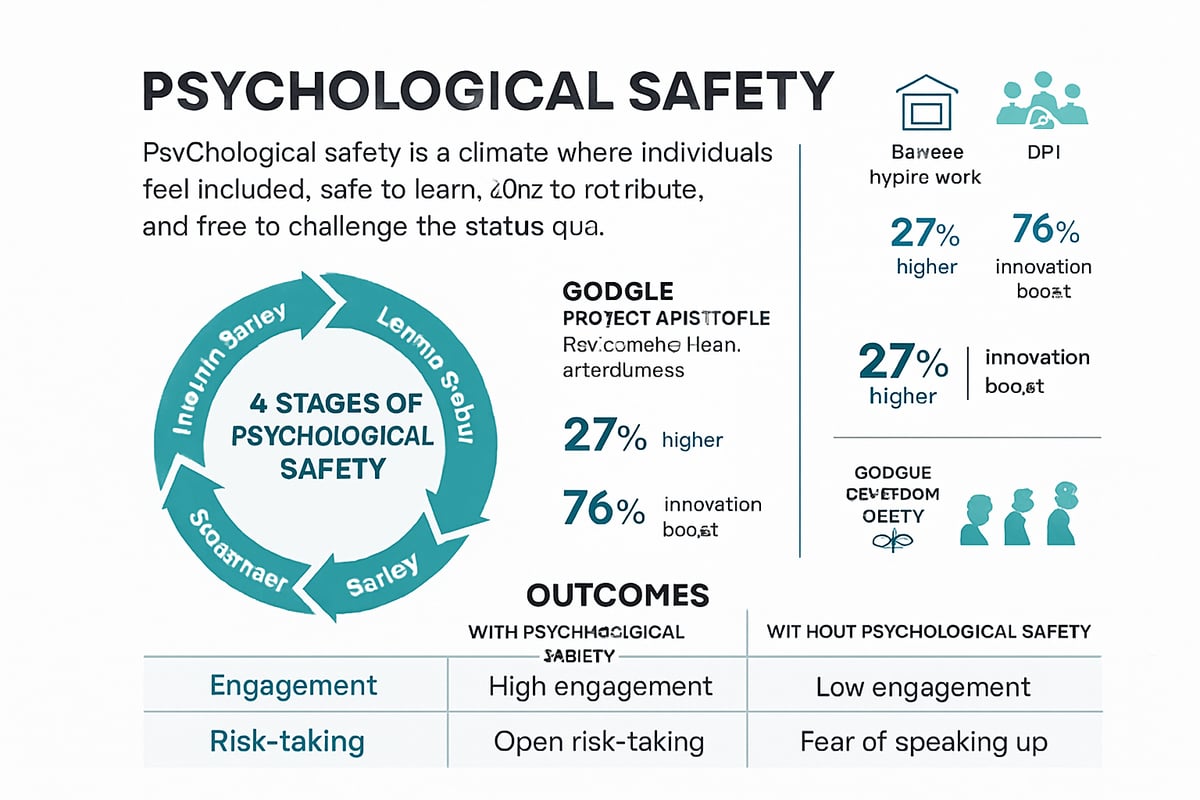
The Four Stages of Psychological Safety
Unlocking high performance starts with understanding the 4 stages of psychological safety. This model, developed by Timothy R. Clark, breaks down how teams move from feeling accepted to confidently challenging the status quo. In today’s fast-paced workplaces, these stages are not always linear. Teams may advance, stall, or revisit earlier stages as dynamics shift. Mastering the 4 stages of psychological safety is essential for leaders aiming to cultivate resilient, innovative teams.
Each stage builds on the last, creating a foundation for trust, learning, contribution, and courageous innovation. Let’s explore what each stage means, how to recognize it, and practical ways leaders can help teams progress.
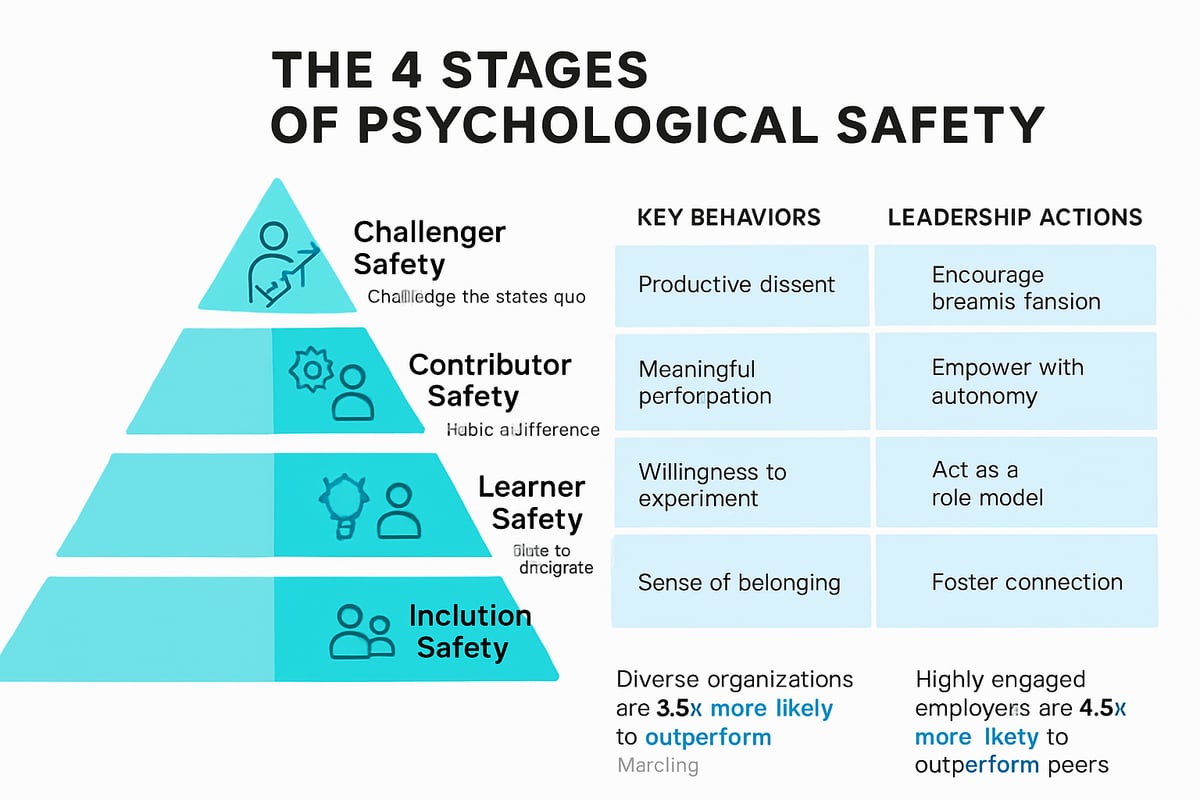
1. Inclusion Safety
Inclusion Safety is the foundation of the 4 stages of psychological safety. At this stage, every team member feels accepted, respected, and valued for who they are. No one is left on the sidelines. Inclusion Safety is about belonging—when people know they are welcome, they can bring their authentic selves to work.
Key Behaviors
- Welcoming diverse backgrounds and perspectives
- Celebrating differences openly
- Ensuring everyone has a voice
Indicators
- Open communication, with no status symbols or cliques
- Personal connections across the team
- High participation in meetings and projects
Leadership Strategies
- Invite input from all team members, especially quieter voices
- Share your own work style and encourage others to do the same
- Be approachable and visible
A company with strong Inclusion Safety sees higher engagement and collaboration. According to McKinsey, diverse teams are 35% more likely to outperform less diverse ones.
Common Challenges
- Unconscious bias can undermine inclusion if left unchecked
- Equal opportunities must be intentional, not assumed
A practical approach is to regularly review onboarding and team rituals to ensure every member feels seen. Inclusion Safety is the launchpad for the 4 stages of psychological safety, making it the first step to team excellence.
2. Learner Safety
Once people feel included, the next phase in the 4 stages of psychological safety is Learner Safety. Here, team members feel confident to ask questions, experiment, and admit mistakes without fear of embarrassment or punishment. This stage is the engine for growth and adaptability.
Key Behaviors
- Treating mistakes as learning opportunities
- Encouraging and giving feedback
- Prioritizing continuous skill development
Indicators
- Mistakes are shared openly, not hidden
- Leaders model vulnerability by discussing their own learning moments
- Learning is built into the team’s rhythm
Leadership Strategies
- Focus on solutions, not blame, when errors occur
- Share your own failures and what you learned
- Dedicate time for regular learning and reflection
Tech companies that embrace a “fail fast” culture are prime examples. They innovate rapidly because team members are not afraid to try and fail. Data shows that teams with high Learner Safety adapt more quickly to disruption and change.
Common Challenges
- Fear of judgment or blame can hold people back from speaking up
- Leaders must consistently reinforce that learning outweighs perfection
Leaders who foster Learner Safety equip their teams to handle uncertainty with confidence, strengthening the 4 stages of psychological safety in practice.
3. Contributor Safety
Contributor Safety marks a turning point in the 4 stages of psychological safety. At this level, individuals feel empowered to contribute their ideas, opinions, and solutions. They are not just present but actively shaping outcomes.
Key Behaviors
- Taking ownership of work
- Recognizing and celebrating contributions
- Promoting autonomy and initiative
Indicators
- High engagement and proactive problem-solving
- Team members volunteer for challenging assignments
- Constructive feedback flows in all directions
Leadership Strategies
- Delegate meaningful responsibilities, not just tasks
- Express gratitude for specific contributions
- Listen actively to new ideas and suggestions
Teams with high Contributor Safety see a surge in innovation and initiative. According to Salesforce, employees who feel heard are 4.6 times more likely to perform their best work.
Common Challenges
- Micromanagement can stifle ownership and creativity
- Building trust takes time and consistency
Contributor Safety is the stage where the 4 stages of psychological safety become visible through results. When everyone feels their work matters, they step up and drive progress.
4. Challenger Safety
Challenger Safety is the pinnacle of the 4 stages of psychological safety. Here, team members are encouraged to question assumptions, challenge the status quo, and share dissenting views—without fear of retaliation or ridicule.
Key Behaviors
- Supporting constructive debate and critical thinking
- Welcoming disruptive ideas and tough questions
- Embracing conflict as a driver for growth
Indicators
- Open discussions about difficult topics
- Willingness to share “half-baked” or unconventional ideas
- Healthy disagreement, resolved respectfully
Leadership Strategies
- Give explicit permission to challenge decisions and norms
- Assign “elephant miner” roles to surface unspoken issues
- Use structured conflict frameworks, like the Thomas-Kilmann Instrument
Organizations with Challenger Safety avoid groupthink and foster breakthrough innovation. Teams that challenge assumptions make better decisions and adapt faster to change.
Common Challenges
- Managing conflict productively without damaging trust
- Ensuring debates remain respectful and focused on solutions
Challenger Safety is where the 4 stages of psychological safety unlock a team’s full creative and strategic potential. By mastering all four stages, leaders create an environment where continuous improvement is the norm.
For a deeper dive into the science and practical steps behind these stages, explore Psychological Safety at Work Explained.
Each stage is interconnected, and progress is rarely perfectly linear. Teams may revisit earlier stages as new members join or challenges arise. The real power lies in consistently nurturing all four stages, making psychological safety an everyday practice.
The Psychological Safety Zones: Comfort, Apathy, Anxiety, and Learning
Understanding the 4 stages of psychological safety is essential, but knowing how these stages translate into everyday team dynamics creates real impact. This is where the concept of psychological safety zones comes in. The psychological safety/accountability matrix maps out how safety and accountability interact, shaping your team’s energy, engagement, and performance.
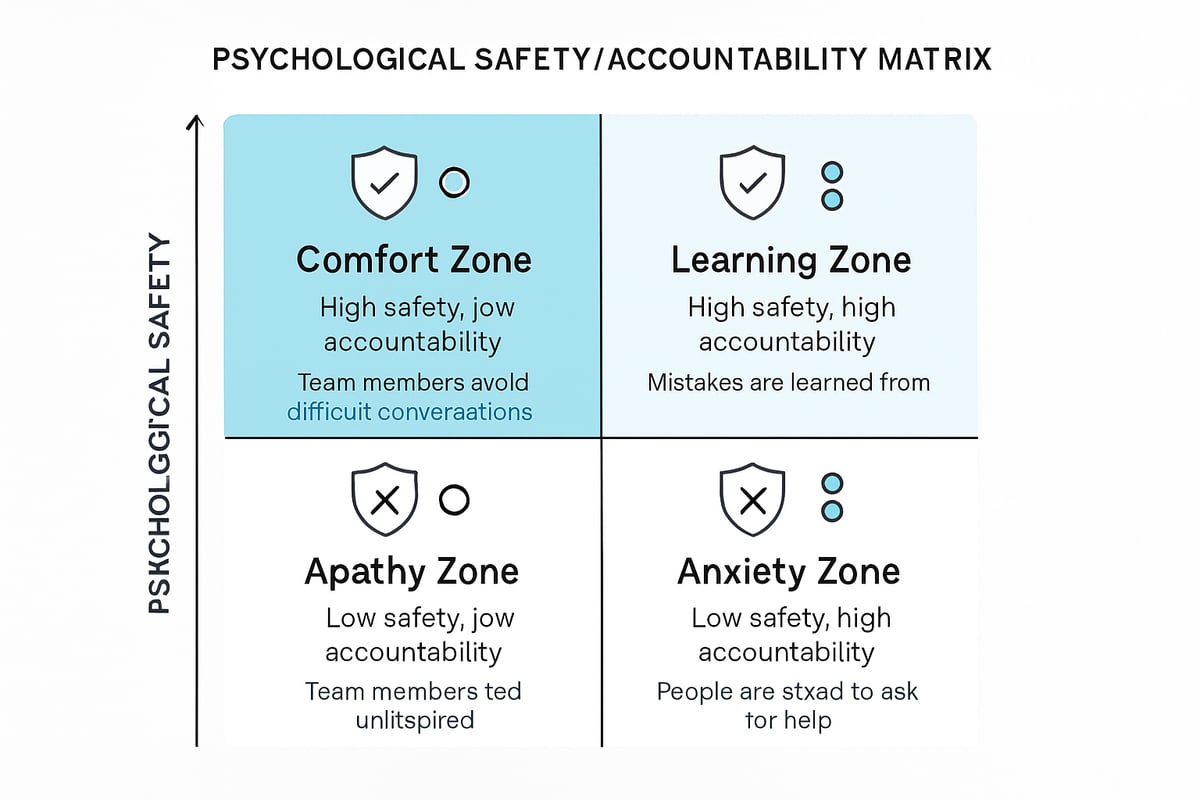
Comparing the Four Psychological Safety Zones
Every team operates within one of four zones, each defined by the interplay between psychological safety and accountability. Here is a quick comparison:
| Zone | Safety Level | Accountability | Team Behaviors | Outcomes |
|---|---|---|---|---|
| Comfort | High | Low | Harmony, little challenge, steady routines | Stagnation, missed growth |
| Apathy | Low | Low | Disengagement, silence, minimal effort | Low morale, high turnover |
| Anxiety | Low | High | Stress, fear of mistakes, burnout risk | Errors, absenteeism, turnover |
| Learning | High | High | Open dialogue, innovation, healthy debates | Growth, high performance, agility |
Teams that understand the 4 stages of psychological safety can spot which zone they are in and take action. The Comfort Zone feels safe but lacks drive. The Apathy Zone is marked by silence and disengagement. Both can go unnoticed until performance suffers.
Moving Teams from Anxiety and Apathy to Learning
The Anxiety Zone is where pressure is high, but psychological safety is low. Here, team members may fear speaking up or making mistakes, leading to stress and burnout. In the Apathy Zone, people check out, feeling neither safe nor responsible for outcomes.
The Learning Zone is the sweet spot. Teams here enjoy high safety and high accountability, producing innovation and peak performance. Research highlighted in Psychological Safety at Work Stats 2025 shows teams in this zone are more resilient and adaptable to change.
To move your team into the Learning Zone:
- Regularly assess both safety and accountability with surveys or feedback tools.
- Celebrate learning from mistakes, not just successes.
- Set clear goals and expectations, while encouraging open dialogue.
- Provide resources and coaching for continuous improvement.
Practical Example: Transitioning to the Learning Zone
Consider a tech team stuck in the Anxiety Zone due to a recent merger. Employees felt pressure to deliver with little room for error, leading to high turnover. Leadership recognized this and began focusing on the 4 stages of psychological safety, starting with inclusion and learner safety.
They implemented weekly check-ins, normalized sharing mistakes, and set clear, achievable goals. Over several months, engagement scores rose, and the team shifted into the Learning Zone. Productivity and innovation soared as team members felt empowered to contribute and challenge ideas.
For organizations aiming to foster this kind of transformation, leadership support and external guidance are crucial.
Leadership Behaviors That Foster Psychological Safety
Fostering the 4 stages of psychological safety begins with leaders who set the tone for trust, openness, and growth. The right leadership behaviors transform team culture and unlock lasting high performance. Let’s break down the essential habits and strategies leaders need in today’s workplace.
Modeling Vulnerability and Openness
Leaders who admit mistakes and share their own learning journeys create a safe space for teams to do the same. When leaders are transparent about challenges, it signals that authenticity is valued over perfection. This approach is foundational for the 4 stages of psychological safety, especially as teams navigate change and uncertainty.
- Share personal experiences and lessons learned
- Invite honest feedback on leadership style
- Admit when you do not have all the answers
Teams become more willing to experiment and voice concerns when leaders model vulnerability. This builds trust and sets a precedent for open dialogue across all four stages.
Inclusive Decision-Making
Including every voice in the decision-making process is crucial for building psychological safety. Leaders should actively seek input from diverse team members and recognize unique perspectives. This ensures that the 4 stages of psychological safety are not just a concept but a daily practice.
- Rotate meeting facilitators to encourage participation
- Use surveys or polls for anonymous input
- Publicly acknowledge contributions and ideas
According to Deloitte, inclusive leaders can boost team performance by up to 17 percent. When everyone feels heard, teams move more easily from inclusion to contribution.
Encouraging Constructive Conflict
Healthy teams do not shy away from disagreement. Instead, leaders promote constructive conflict by normalizing debate and making it clear that challenging ideas is a sign of engagement, not disrespect.
- Assign a “devil’s advocate” in discussions
- Use conflict resolution frameworks for tough topics
- Praise respectful dissent and solution-oriented debate
Constructive conflict is essential for the 4 stages of psychological safety, particularly at the challenger stage, where innovation depends on open, honest conversations.
Providing Consistent Feedback and Recognition
Regular feedback and public recognition are powerful tools for reinforcing the 4 stages of psychological safety. Leaders who prioritize feedback create an environment where growth is expected and celebrated.
- Schedule weekly one-on-ones with team members
- Recognize individual and team achievements in meetings
- Offer specific, actionable feedback rather than generic praise
When feedback is routine, teams are more likely to take risks, learn from mistakes, and contribute new ideas.
Addressing Toxic Behaviors Quickly
A psychologically safe environment cannot exist where toxic behaviors go unchecked. Leaders must act swiftly to address exclusion, blame, or disrespect. This proactive approach protects the integrity of the 4 stages of psychological safety.
- Intervene immediately when negative behavior arises
- Set clear expectations for respectful communication
- Model empathy and accountability in difficult moments
For actionable strategies, leaders can explore Building Psychological Safety Strategies to deepen their impact.
Continuous Learning and Growth Mindset
Leaders who invest in continuous learning set the stage for long-term team development. Encouraging ongoing skill-building and curiosity ensures the 4 stages of psychological safety become embedded in daily operations.
- Host regular training or knowledge-sharing sessions
- Celebrate learning from both successes and failures
- Encourage experimentation and adaptability
Organizations that prioritize learning not only retain top talent, they also drive consistent innovation.
How Leadership Coaching Accelerates Psychological Safety
Leadership coaching has become an essential catalyst for organizations committed to mastering the 4 stages of psychological safety. While many leaders understand the theory, translating it into daily team behaviors often requires targeted support and expert guidance.

Coaching provides leaders with the tools to accurately diagnose where their teams stand within the 4 stages of psychological safety. Through structured reflection and feedback, coaches help identify blind spots and bridge the gap between intention and impact. According to the Wiley Survey on Psychological Safety Gaps, significant disparities exist between how executives and employees perceive psychological safety, highlighting the need for external insights.
Noomii’s approach is grounded in evidence-based assessments and precision coach matching. Every engagement begins with a thorough evaluation of team dynamics using validated tools, ensuring that interventions are tailored to each stage of the 4 stages of psychological safety. Coaches then design targeted plans focused on building trust, enhancing communication, and raising accountability to foster sustainable change.
Outcomes are measured through clear KPIs and cultural health indicators, making progress visible and actionable. This data-driven approach aligns with organizational compliance standards and supports long-term transformation. For HR leaders and executives, leadership coaching offers a scalable solution to embed psychological safety at every level, ensuring that each of the 4 stages of psychological safety is addressed systematically.
Consider a company that struggled with low engagement and high turnover, stuck in the apathy and anxiety zones. Through coaching, leaders learned to address root causes, implement consistent feedback, and move their teams into the learning zone. The result was a measurable boost in innovation and morale. If you’re ready to accelerate your journey through the 4 stages of psychological safety, explore how leadership coaching can transform your team’s culture and results.
Practical Strategies to Build Psychological Safety in 2025
Building a culture of psychological safety is not a one-time event. It is an ongoing journey that requires intention, measurement, and action across every stage. Here is how organizations can practically implement the 4 stages of psychological safety and create thriving teams in 2025.
Assessing Your Team’s Current Stage
Start by evaluating where your team stands within the 4 stages of psychological safety. Use validated surveys, pulse checks, or facilitated discussions to gather honest feedback on inclusion, learning, contribution, and challenge. Leveraging resources like the Meta-Analysis of Psychological Safety Measures can help you identify the right tools and benchmarks.
Look for patterns in participation, openness, and willingness to share. This data guides targeted interventions and sets a baseline for future progress.
Actionable Steps for Each Stage
Once you know your team’s stage, apply focused strategies:
- Inclusion: Host team-building and diversity workshops, update onboarding to spotlight belonging, and celebrate unique backgrounds.
- Learner: Create regular “fail forward” sessions, reward curiosity, and encourage peer-to-peer skill sharing.
- Contributor: Delegate meaningful projects, recognize wins publicly, and promote cross-functional mentoring.
- Challenger: Schedule “devil’s advocate” meetings, introduce structured debate, and normalize dissenting opinions.
By customizing your approach for each stage, you reinforce the 4 stages of psychological safety and drive sustainable cultural growth.
Embedding Psychological Safety in Remote/Hybrid Teams
As work becomes more distributed, psychological safety must extend beyond physical offices. Use clear communication channels, inclusive virtual meetings, and regular check-ins to ensure everyone feels seen and heard.
Leverage collaboration tools for anonymous feedback and open brainstorming. Rotate meeting facilitators to balance participation. These habits help remote teams progress through the 4 stages of psychological safety, preventing isolation and disengagement.
Measuring Progress and Sustaining Momentum
Track progress by setting clear metrics: survey scores, retention rates, and participation levels in meetings. Schedule regular reviews to discuss what is working and where gaps remain. The Perceptyx Report on Psychological Safety Gap highlights the cost of silence and the value of continuous measurement.
Celebrate milestones and share stories of improvement to reinforce positive change. Adjust strategies as your team evolves.
Overcoming Common Barriers
Common obstacles include resistance to change, time constraints, and lack of leadership buy-in. Address these by educating stakeholders, building leadership capability, and providing ongoing resources.
For organizations seeking expert support, explore leadership development solutions like Accountability Now to accelerate progress through the 4 stages of psychological safety and create a culture where every voice matters.
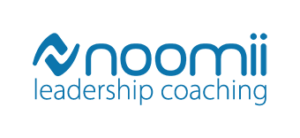
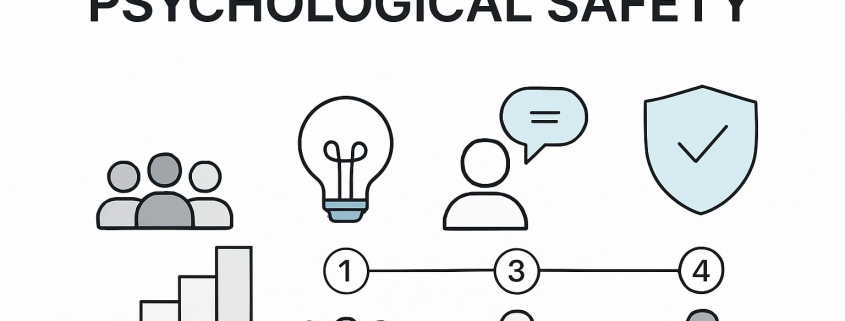


Leave a Reply
Want to join the discussion?Feel free to contribute!